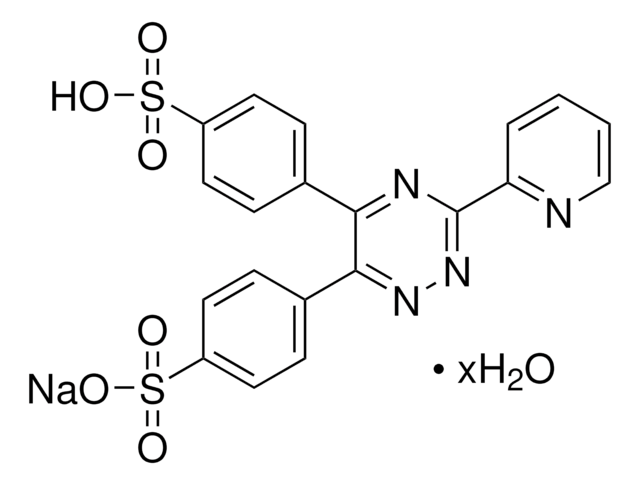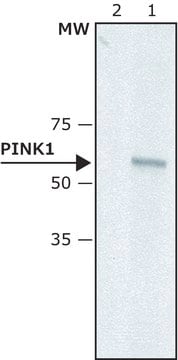P5338
3-(2-Pyridyl)-5,6-diphenyl-1,2,4-triazine-4′,4′′-disulfonic acid sodium salt
Powder
Synonim(y):
5,6-Diphenyl-3-(2-pyridyl)-1,2,4-triazine-4′,4″-disulfonic acid sodium salt, PDT disulfonate
About This Item
Polecane produkty
product name
3-(2-Pyridyl)-5,6-diphenyl-1,2,4-triazine-4′,4′′-disulfonic acid sodium salt, BioXtra
linia produktu
BioXtra
Poziom jakości
Postać
powder
zanieczyszczenia
≤0.0005% Phosphorus (P)
≤0.1% Insoluble matter
mp
≥300 °C
ślady anionów
chloride (Cl-): ≤0.1%
ślady kationów
Al: ≤0.001%
Ca: ≤0.01%
Cu: ≤0.0005%
Fe: ≤0.0005%
K: ≤0.005%
Mg: ≤0.001%
Pb: ≤0.001%
Zn: ≤0.0005%
Zastosowanie
diagnostic assay manufacturing
hematology
histology
temp. przechowywania
room temp
ciąg SMILES
[Na+].OS(=O)(=O)c1ccc(cc1)-c2nnc(nc2-c3ccc(cc3)S([O-])(=O)=O)-c4ccccn4
InChI
1S/C20H14N4O6S2.Na/c25-31(26,27)15-8-4-13(5-9-15)18-19(14-6-10-16(11-7-14)32(28,29)30)23-24-20(22-18)17-3-1-2-12-21-17;/h1-12H,(H,25,26,27)(H,28,29,30);/q;+1/p-1
Klucz InChI
ZGVNYCXXBQPDPQ-UHFFFAOYSA-M
Szukasz podobnych produktów? Odwiedź Przewodnik dotyczący porównywania produktów
Powiązane kategorie
Opis ogólny
Zastosowanie
It has also been used in ABTS radical scavenging assay to determine the antioxidant activity of honey samples.
Kod klasy składowania
11 - Combustible Solids
Klasa zagrożenia wodnego (WGK)
WGK 3
Temperatura zapłonu (°F)
Not applicable
Temperatura zapłonu (°C)
Not applicable
Środki ochrony indywidualnej
Eyeshields, Gloves, type N95 (US)
Choose from one of the most recent versions:
Masz już ten produkt?
Dokumenty związane z niedawno zakupionymi produktami zostały zamieszczone w Bibliotece dokumentów.
Klienci oglądali również te produkty
Nasz zespół naukowców ma doświadczenie we wszystkich obszarach badań, w tym w naukach przyrodniczych, materiałoznawstwie, syntezie chemicznej, chromatografii, analityce i wielu innych dziedzinach.
Skontaktuj się z zespołem ds. pomocy technicznej














